A good SHTF first aid kit is one of the important items that many Preppers neglect.
Unfortunately, they don’t even know it. That’s because most people have a first aid kit that they picked up at the local pharmacy or department store for $29.95 and then believe they’re safe. But this is not enough in any way to prepare you for emergencies. That’s enough to treat split fingers and skinned knees, that’s it.
If you’ve made your own first aid kit from SHTF or bought a decent trauma kit, you probably don’t have anything near what you need. This may be true, even though you’ve got a good trauma kit. You see, a SHTF first aid kit needs to have broad width and scope for survival purposes and most commercially produced kits don’t have that.
What do I mean by breadth and depth?
Breadth means being able to deal with a wide variety of specific injuries including serious injuries (trauma). A good trauma kit will have that, but the local pharmacy version won’t. Depth ensures that the supplies that are included in that first aid kit will take care of some of those severe injuries. Even the best emergency kits are having trouble in this, unless you personally purchase one that a paramedic or EMT use.
During a time of crisis, medical facilities tend to get overcrowded making them almost impossible to function. Just look at how the hospitals looked like during Katrina Huricane. On top of that, even getting to the nearest hospital or clinic can be a challenge. Yeah, it may very well be a lifesaver for anyone in your family to have the fully stocked SHTF first aid kit.
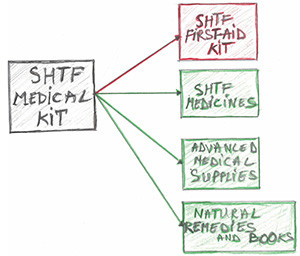
Please note that this is just first aid.
A SHTF first aid kit (as seen in the graphic) is not a full emergency kit. What you do with first aid is keep things from getting worse or more dangerous. That’s fine, by itself, but it may not be enough.
This article revolves around creating the first aid kit for SHTF. You may want to read this article if your interested in “SHTF Medicines.”
“Advanced Medical Supplies” are intended for use by physicians or qualified persons. A good medical supply for example would be adrenaline. When used by an untrained person, may even cause his death instead of helping others.
The Kit Itself
To begin with, you need to use something to put all of that stuff in. It needs to be something you can arrange the content in well, so it is best to have a case with lots of dividers or small compartments in it. There are also emergency kits available in a soft-case, which is easier to carry with you. Yet it’s hard to find a case that’s big enough like this. I’ve got a first aid kit that I’ve built into a roll-up shaving kit that I carry in my car. However, for my primary SHTF first aid kit, this is not big enough.
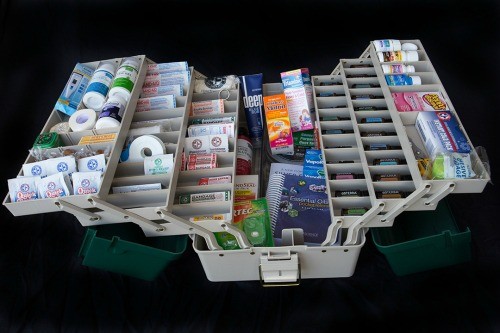
My main kit comes in a big tackle box for fishing. The cantilevered trays offer a perfect place to organize the tiny items and the box’s open bottom offers me a nice place for the bigger items. This makes a kit easy to grab, which I can take with me where it is needed. Working with them is also really convenient, mainly because the case makes it easy to organize.
The Contents
I strongly recommend that you go with better medical supplies and only decent medical supplies. This is another issue I experience with most commercial first aid kits. We are using the cheapest, rather than using the best quality materials we can. This makes a difference, like in holding a bandage in place. When it isn’t great, chances are, it will come off when you don’t want it to.
Hygiene
Most of the wounds just don’t kill directly. The only way a wound can kill directly is by damage to a major organ. They usually kill by making the patient bleed out or by infection. Bandaging is recommended to prevent bleeding, but the patient will still die of an infection if the wound is not kept clean.
For that reason, keeping the wound and surrounding area clean is extremely necessary. That also means you are preventing the introduction of any bacteria into the wound. And, before treating the patient, you have to clean up your own act. This also helps protect you from any potential infectious diseases that they might have.
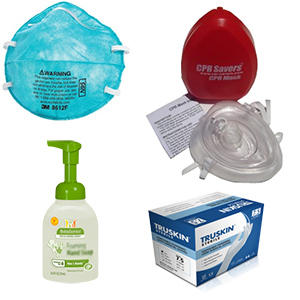
- Anti-bacterial hand cleaner – Always wash up before treating a wound
- Sterile rubber gloves – Make sure they are the sterile type and not just rubber gloves
- Medical face mask – So that you don’t breathe any germs onto the wound
- CPR mask – If you need to provide CPR, this protects both you and the patient from infections (in the right upper corner of the picture)
Flesh Wounds
Flesh wounds are the majority of what a SHTF first aid kit is designed to treat. That means everything from a paper cut to a severed limb. Your aim in providing first aid is to stop the bleeding and protect the wound in any case. This can require several different items depending on the extent of the wound.
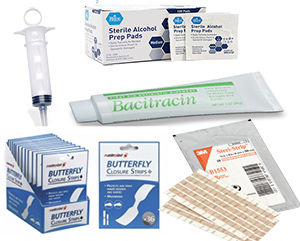
- Irrigation syringe – Before bandaging the wound, it needs to be cleaned out. This is done by squirting clean water into it. If the water is clean enough to drink, it’s clean enough for irrigation
- Alcohol towelettes – For cleaning the wound and the area around it. Have a goodly supply, because they are rather small
- Antibacterial ointment – Put on the wound to kill bacteria that can cause infections
- Butterfly closures or Steri-strips – Both are used to close wounds where the skin is open or separated. This will help protect the wound, reduce bleeding and encourage healing
Related: 11 Unusual and Uncommon First Aid Items
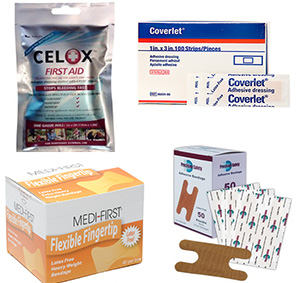
- Clotting agent – There are several brands of these available, such as Celox or QuikClot. They are designed to help speed up the clotting process. Available as crystals to sprinkle on the wound or imbedded in a bandage
- Cloth adhesive bandage strips – The cloth type are flexible, so they won’t pop off when the patient move
- Cloth knuckle bandages – One of the hardest things to bandage is a knuckle, because of the movement. This specialty bandage will keep scraped knuckles clean, moving with the finger
- Cloth fingertip bandages – Another specialty bandage for a hard-to-bandage area
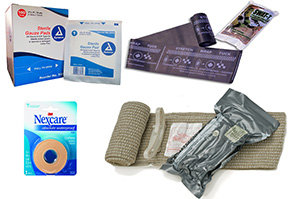
- Large bandages – Stock some 4″x 6″ and 2″x 3″ sterile gauze pads for dealing with medium sized wounds. These will not have adhesive on them. If you don’t have these, and if it’s an emergency, you can substitute them with sanitary napkins.
- Medical tape – For use in holding those bandages in place. The newer “cohesive tape” works much better, sticking to itself, rather than to the patient’s skin. No pain of pulled out hairs when removing the tape. You definitely need some of these in your SHTF first aid kit.
- SWAT Tourniquet – Useful as a tourniquet, but also as a pressure dressing when only tightened half-way. Pressure on the wound reduces the bleeding
- Israeli bandage – The Israeli bandage is a combat bandage designed for use in the Israeli military. It combines a clotting agent with a bandage and a wrap to hold the bandage in place. Used properly, it is also a pressure bandage to reduce bleeding. These are available in 4″ and 6″ sizes. One of the easiest ways to treat a serious wound
As you can see, there is a lot here. That’s partially because of needing different sizes of bandages for different types of wounds. But at the same time, you can literally use half the items listed here for one wound, if it is a serious one.
Broken Bones
Broken bones fall into two general categories: fractures and compound fractures.
A compound fracture happens when the bone ends sticking out through the skin. The fracture must be treated in such situations, and the open wound must be treated. A simple fracture eliminates the need for open wound treatment, leaving only the broken bone to treat.
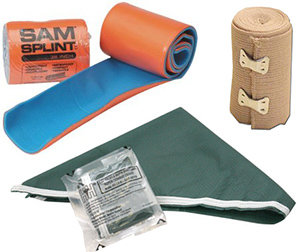
- Sam splint – While just about anything can be used for making a splint, a Sam splint is much easier. This is a sheet of soft aluminum, covered with about 1/4″ of foam rubber. You can cut it with medical scissors and form it with your hands. This makes it easy to make a splint that will protect pretty much any break
- Elastic bandages – Commonly referred to as “Ace bandages,” you will need these to hold the Sam splint in place. They are also useful for dealing with sprains and damaged ligaments
- Combat cravat – Referred to as a bandage, it’s really just a big triangular piece of fabric, normally olive drab in color. Ideal for use as a sling for broken arms.
Related: 16 Free Alternative Pain Meds
Medical Tools to Have in Your SHTF First Aid Kit
You’re going to need a few tools to work with, both for treating trauma and for simple diagnosis of disease. While you and I aren’t trained medical personnel, a few tools can make a lot of difference.
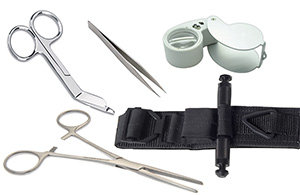
- Medical scissors – For cutting off old bandages, as well as cutting off clothing to get to wounds. You want a good pair, so that you can cut through the seams of a pair of blue jeans with them
- Fine-pointed tweezers – Useful for removing pieces of gravel from wounds and splinters from fingers
- Jeweler’s loupe – A magnifying glass that is held in place by the eye socket. Great when you’re trying to find those little splinters or cactus thorns to remove with the tweezers
- Hemostats – In the case of a severed limb, hemostats allow you to close off veins that are pumping blood
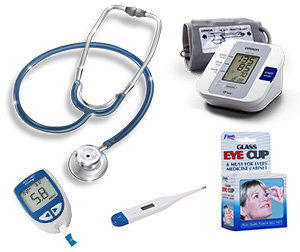
- Tourniquet – Buy the one-handed kind, so you can use it on yourself, if needed. The idea is not to cut off all blood flow, but to slow it down until clotting occurs
- Stethoscope – For checking heartbeat (not an absolute requirement)
- Blood pressure monitor – Dropping blood pressure is a sign of internal bleeding. If the patient is acting faint, check their blood pressure
- Blood sugar monitor – Low blood sugar can cause people to lose strength, coordination, become shaky and not think clearly. If someone is acting like they are faint, this is a common thing to check
- Thermometer – For checking the patient’s temperature. Infections, whether systematic or from a wound, will cause an increase in temperature. The in-ear type of thermometers are best
- Eye cup – Used with sterile water or saline, the eye cup is for cleaning debris out of the eye
Related: Personal Hygiene First Aid
Other Things to Put in Your SHTF Emergency Kit
There are lots of different things you may want to consider adding to your SHTF first aid kit, including over the counter medications. It’s not my purpose to speak about those here, but look at the things you frequently use and make sure you have a good stock of them.
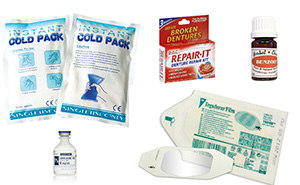
- Instant cold packs – Applied to a sprain or other non-bleeding injury, these can reduce swelling; but they must be applied quickly, as they only have an effect in the first 15 minutes
- Dental repair paste – While not technically a trauma item, a chipped tooth or a cavity can cause a lot of pain. Filling it temporarily with this paste can relieve the pain and make it possible to function for a few days
- Tagaderm – A transparent film dressing, ideal for use over rashes and burns to hold in the medical cream that you apply to the irritated skin
- Benzoine – You can get by without this most times, but benzoine is used to clean the area around a wound, so that the adhesive on the bandage will stick
- Lidocane – A local antiseptic which can be injected or applied topically to reduce pain in a wound. May be necessary, in order to get the patient to allow you to touch the wound
- Anti-inflammatory medicines – I’m sure there are over 25 brands to choose from. But because we are talking about an SHTF first aid kit, I’m thinking that you might want to add something with at least medium effects like Diclotard.
I know this is a fairly lengthy list, but it’s really just the basics. Items which can be used without medical experience. Otherwise many items like Hydrocortisone, Chlorphenamine, Antihistamins should have been included in the list. Adrenalina, plus that much more!
There is a good chance that you will need every item on this list at a time when you can not just call for an ambulance. Although I hope this isn’t so, I would rather see you getting ready.











